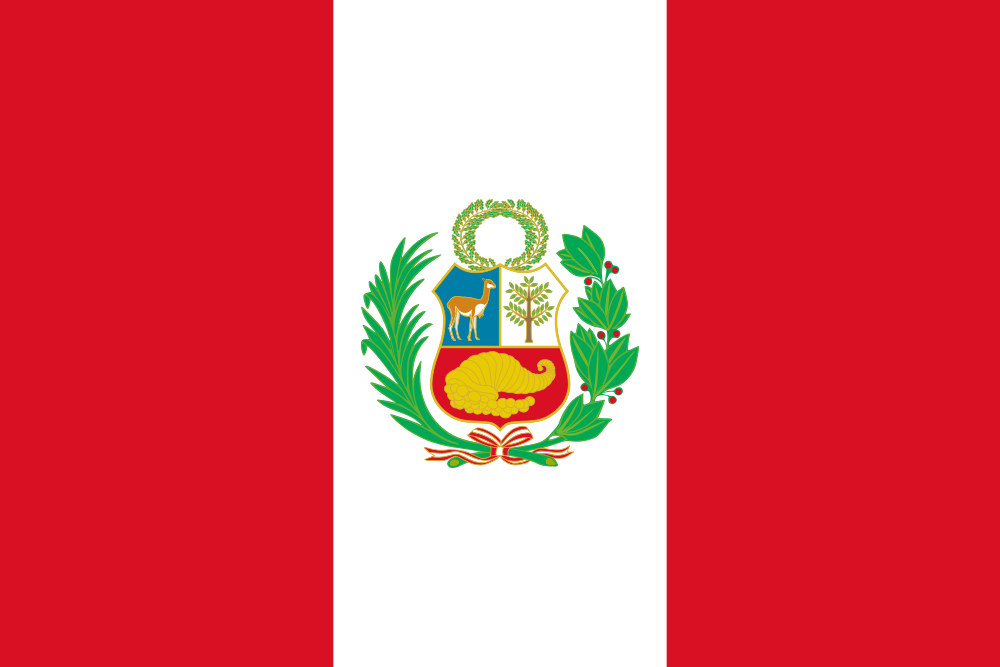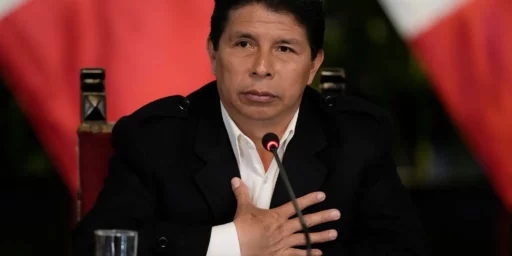Peru to the Polls
A problematically wide-open election in difficult times.

It is election day in Peru. Peruvians are going to the polls today for the first round of presidential elections, congressional elections, and Andean parliament elections. As the NYT reports, it no exactly a celebration of democracy: In Peru’s Presidential Election, the Most Popular Choice Is No One.
Peruvians are voting on Sunday at a moment many are calling one of the lowest points in the country’s young democracy. Eighteen candidates are on the ballot, but about 15 percent of voters are expected to cast a blank vote, according to several recent polls, and no candidate has been able to garner much more than 10 percent support. The leading two candidates will advance to a runoff if no one captures more than half the vote.
As much as I celebrate, in a general sense, lots of choices for citizens, eighteen is a lot of candidates especially if there are not at least moderate-sized parties to draw decent support. If, in fact, the first round produces run-offs contestants in barely over single digits, there is a clear issue of weak-to-nonexistent parties. Of course, the only good news here is that at least the winner will have to eventually win an absolute majority. If the blank vote wins, that would certainly be a signal of substantial discontent. A blank vote is literally an unmarked ballot deposited in the ballot box. It would have not effect on the next round, however.
The context is, to be blunt, not good at all:
The election follows a tumultuous five-year period in which the country cycled through four presidents and two Congresses, and it comes amid growing frustration over corruption, the pandemic and a political system that many say has served the interests of corporations and officials — but not of regular people.
[…]
Peru has one of the highest coronavirus death rates in the world, and daily deaths climbed to new highs this month as the Brazilian variant of the virus spread through the country. Many Covid patients have died amid lack of access to oxygen or ventilators, working-class families are struggling to secure enough food, and school closures have pushed children into the labor force.
The economy shrank 12 percent last year in the country’s worst recession in three decades — the second-worst downturn in Latin America, after Venezuela’s.
Weak parties in the context of national difficulties is not a new story in Peru, but it is worse than it has been. Indeed, this article sparks two memories.
One is from the last time I was in Peru, which was in 2006, and the mood at the time was that no one was happy with any of the choices. Alan García would go on to win his second go at the office–his first (1985-1990) had ended in failure and eventual exile in 1992–García committed suicide in 2019 as he was facing corruption charges. So, the notion of discontent with politics is not new. And García’s history is in many way emblematic of the country’s politics for the last 40+ years. Without getting into a long digression he has represented, at times, great optimism for the country and great tragedy. That he, a two-term president in two distinct eras of Peruvian politics, ended his life over serious corruption charges simply underscores the long-term dsyfunction.
The second memory is from early in my career the first time I remember hearing Steven Levistky’s name (he of recent How Democracies Die fame). It was at a panel at the the Latin American Studies Association meeting and it was about the question of whether Peru was a democracy without parties. I cannot remember if Levitsky was on the panel (I don’t think he was), if the panel was a discussion his work (perhaps a version of his 1999 piece, “Fujimori and Post-Party Politics in Peru“), or if he just got brought up in the discussion.
The idea of a democracy without parties is of note for a variety of reasons (chief among them the fact the representative democracy tends to lead to party development), so I think that is why I remember it plus there was direct linkage to research I was doing on Colombian party development. In looking at the Journal of Democracy piece linked in the previous paragraph, I would note this passage that is relevant to the NYT description of current conditions in Peru (pps. 86-87):
post-Fujimori democracy is likely to be a democracy without political parties. The Peruvian party system has disintegrated to a degree that is unrivaled in Latin America. Whereas in the 1980s four parties–the United Left, APRA, AP, and the PPC–accounted for roughly 90 percent of the vote, a decade later the same parties accounted for less than ten percent of the vote. Moreover, these traditional parties have been replaced not by new parties–at least not as we conventionally understand parties–but by “independent movements,” which are really personalistic
campaign vehicles that are discarded after elections. At both the national and local levels, political entrepreneurs now routinely calculate that they are better off without a party than with one. Thus they are defecting from traditional parties and essentially running on their own, creating a multiplicity of candidate-centered movements that lack horizontal or cross-territorial ties to one another. They also tend to lack ideological bases. Without an appeal that transcends the individual candidate, many of these new “independent movements” have adopted names based on the locality in which they are competing, such as “Eternal Cuzco,” “Ayacucho ’95,” “We are Huancayo,” and “Union for Puno.” Similarly, recently founded parties at the national level have called themselves “We Are Peru,” “Peru
Now,” “Possible Peru,” and “Peru Toward 2000.”
Since in my own work I have long used a very minimalist definition of “party” (basically a vote-seeking label) I was inclined at the time to see this an extremely weak, poorly institutionalized party system (and a phenomenon I was familiar with, although not at quite the same scale, in Colombia). Regardless of any of that, what Levitsky described in 1999 is fully in bloom in Peru right now.
A country does not get to a list of 18 presidential candidates, none of which are polling at much more than 10% if there is any kind of healthy party system in place. A key function of parties is supposed to be the coalescing voters around candidates who share their general views and interests–and Peru is not so divided that 18 parties makes any semblance of sense.. A system needs some level of long-term stability for government to function. While ephemeral parties linked to vanity candidacies are not in and of themselves problematic, if a country’s party system is dominated by them, that’s a serious problem.
Indeed, it manifests in things like this:
Three former presidents have spent time in jail during bribery investigations, including one candidate in this year’s election; a fourth killed himself to avoid arrest; and a fifth, Mr. Vizcarra, one of the most popular recent leaders, was impeached in November.
His replacement, who lasted less than a week in office, is under investigation in connection with the fatal shootings of two young men at protests, which led to his resignation.
One reason for the country’s endemic corruption is that political parties often barter their loyalties to presidential candidates in back-room deals, and are often captive to special interests.
And:
“Political parties are no longer a vehicle for representation of the citizenry,” said Adriana Urrutia, a political scientist who leads the pro-democracy organization Transparencia.
“There are parties in the current Parliament that represent the interests of private universities facing penalties for failing to fulfill minimum requirements,” she added. “There are parties that represent the interests of illegal economies, like illegal logging and illegal mining.”
Corruption, poor economic outcomes, terrible Covid response, and the lack of adequate representation (all long-term stories in Peru, aside from the specifics of Covid) all are contributing to a serious lack of support for democracy in the country.
More from AS/COA: Explainer: Peru’s 2021 General Elections





Peru, Peru, Peru. I am sick of the way Peru dominates our political discourse.
Quick question: is this statement true in any similar way if you change from “country” to “politcal party?” Does a 15, 16, 17 candidate primary race indicate similar dysfunction?
Peru is waiting to become the leading country of Spanish South America if they find the right leader. The country has so much potential one can literally smell it wherever one goes.
What’s your sense of how these events will affect (and/or vice versa) crypto and the blockchain in Peru? On the one hand, the dysfunction noted in your last sentence creates a perfect situation for crypto to take hold and expand. On the other hand, the dysfunction could breed nationalism and a subsequent crackdown.
Or instead, to scale out to South America more broadly, I’m interested in your thoughts on crypto and whether you are bullish or bearish on it. The fanboys constantly extol its virtues, as fanboys do, but I’m interested in your take as a political scientist.
Any thoughts on either?
@Michael Reynolds: There is no escape, it would seem.
@Just nutha ignint cracker: The key part of that sentence is “none of which are polling at much more than 10%.”
If you had a US party that had 18 candidates and none could muster more than 12% in each primary, that would suggest some serious internal problems in that party (and even raise the question as to why the party exists).
The 18 candidates aren’t the main problem, is that none of them have much support. I have seen races with lots of candidates, but usually, it means one has 35% and another 30% and a lot with only 5% or 1%
@Mimai: I am utter non-expert on that subject.
My layman’s view is that cryptocurrency is a fad based on the mistaken belief that fiat currency is going to collapse.
If I were betting, I would bet that cryptocurrency collapses before state-based currencies do. But, again, I really have no basis for making definitive claims on this subject.
@Steven L. Taylor: Thanks for the explanation. I think I see the difference.